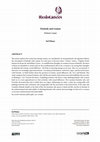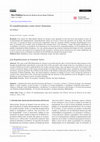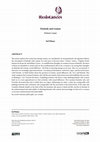Articles published by Sol Pelaez

An Intimacy of Strangers: An Aesthetic Clinic
Journal of Modern Literature Vol. 47, No. 2 • , 2024
Fernanda Negrete. The Aesthetic Clinic. Feminine Sublimation in Contemporary Writing, Psychoanaly... more Fernanda Negrete. The Aesthetic Clinic. Feminine Sublimation in Contemporary Writing, Psychoanalysis and Art. SUNY Press, 2020. 345 pp. $53.01 hardcover; $35.95 paper.
Fernanda Negrete’s The Aesthetic Clinic. Feminine Sublimation in Contemporary Writing, Psychoanalysis, and Art proposes art as a therapeutic that does not embrace the dream of homeostasis, but it is linked to a feminine enjoyment and to an experience of non-totalization. Through the work of Louise Bourgeois, Sophie Calle, Lygia Clark,
Marguerite Duras, Roni Horn, and Clarice Lispector, Negrete makes art intervene in psychoanalysis and vice versa. Tracing an intractable and incurable jouissance, in which intensity overflows what is communicable and does not settle in the signifier or the Oedipal structure, she puts into conversation Freud, Lacan, and Deleuze. Art, Negrete argues, shares the experience of the excessive enjoyment of the feminine. Thus, critics
desire the knowledge of the unconscious, a knowledge that cannot be mastered or totalized because it decenters not only the artist but also the viewers and the critics.
Keywords: psychoanalysis and art / feminine enjoyment / intimacy

Notas sobre la diferencia sexual: entre el feminismo y el psicoanálisis lacaniano
Destellos de una política bioafirmativa: andar y desandar las violencias políticas contemporáneas, 2023
En este ensayo analizaremos la diferencia sexual a partir del marco de ciertas vertientes del psi... more En este ensayo analizaremos la diferencia sexual a partir del marco de ciertas vertientes del psicoanálisis lacaniano. Para eso, examinaremos brevemente cómo ha sido considerada y criticada la diferencia sexual por algunas pensadoras feministas, para luego entrar en cómo el psicoanálisis lacaniano interviene en esta discusión. Propongo pensar la diferencia sexual a partir de las fórmulas de sexuación de Jacques Lacan (1998, 2018) y las lecturas de ellas por parte de Joan Copjec (1994) y otros teóricos y clínicos lacanianos, incluyendo a aquellos, como Patricia Gherovici (2019), que analizan la subjetividad trans* sin patologizarla. De acuerdo a Joan Copjec, uno de los descubrimientos del psicoanálisis es que el ser es sexuado. La sexuación no es un atributo del ser, algo que se agregue a una base neutra. El ser es sexuado de manera ontológica a través de la diferencia sexual entre dos posiciones la masculina y la femenina pero esta diferencia no es ni biológica ni social-cultural sino lógica y psíquica. La afirmación de Lacan de que no hay relación sexual significa que no hay lógica predeterminada que vincule a los sexos. Por lo tanto, estas dos posiciones no deben ser pensadas biológicamente o culturalmente sino como dos formas de subjetivación que no entran en relación lógica entre sí. Mientras la llamada posición masculina se organiza dentro de la lógica de la excepción, del Otro y la totalidad (aunque se reconozca como imaginaria), el lado llamado femenino se constituye en el conocimiento de que no hay Otro del Otro que pueda fundar el orden social y del no-todo (o la aceptación de la imposibilidad de la totalidad). El psicoanálisis ha sido criticado por conservar el binarismo biológico que jerarquiza la perspectiva masculina sobre la femenina. Sin embargo, si sostenemos la hipótesis de Lacan de que no existe tal cosa como la relación sexual, la diferencia sexual es justamente lo que interrumpe este binarismo. Las dos posiciones delineadas por Lacan no marcan dos lugares esenciales (masculino y femenino), sino justamente dos posiciones que no entran en relación lógica (sea ésta opuesta, complementaria, biológica, cultural).

Resistances. Journal of the Philosophy of History, 2023
This article explores the connection among woman, sex, and finitude. In stuying finitude, the arg... more This article explores the connection among woman, sex, and finitude. In stuying finitude, the argument follows the articulation of finitude with woman. In a first part, it discusses three "women" writers-Virginia Woolf, Simone De Beauvoir, and Hélène Cixous-to establish their thoughts on woman in terms of finitude. The three of them are identified as women and yet they problematized what to be a woman is. In tracing their thoughts on finitude and woman, sexual difference-the body as enjoying emerges as an issue. Thus, in a second part, it discusses two seemingly opposed positions-Lacanian psychoanalysis, with Joan Copjec, and deconstruction, with Derrida-to think further about the question of woman, sexual difference, the "two, " and finitude. This study compares the Lacanian feminine side with the movement of deconstruction and establishes the necessity of thinking a "two" beyond the binary of phallogocentrism. My thesis is that thinking finitude with woman leads us to a non-oppositional two that correlates with sexual difference. The Lacanian feminine side, and Derrida's deconstruction aim to think these two logics, delineating two sides: a male one (comparable with phallogocentrism) and a feminine side (comparable with the movement of deconstruction). If the male side considers finitude (death) as the limit of life, the feminine side opens to death and life, and the in-finitude of the undetermined and undecidable. In thinking finitude with woman, the knowledge of what to be a woman is, becomes undetermined and undecidable.
Actas del VII Coloquio Internacional de Filosofia del Conocimiento, UNLP, Argentina, 2021

Res Pública. Revista de Historia de las Ideas Políticas, 25(2), 75-85., 2022
Resumen. Este ensayo lee Materialismo Salvaje de Jacques Lezra siguiendo la ética del terror que ... more Resumen. Este ensayo lee Materialismo Salvaje de Jacques Lezra siguiendo la ética del terror que propone el autor en su pensamiento del republicanismo. Específicamente rastrea en el texto el terror del encuentro con la mujer. De acuerdo con Lezra, el concepto de Mujer es pivote para comprender cómo los conceptos (débiles) emergen. Repetidamente en su obra, el encuentro con la mujer corroe la fantasía del concepto fuerte y del soberano, y surge otra lógica republicana, no escatológica, no heroica, no sacrificial. Nos enfocaremos en el fracaso de la comunidad sadiana y en la emergencia de otra posible comunidad en María Zambrano. Así, este artículo propone una relectura feminista del trabajo de Lezra, rastreando el efecto corrosivo de la mujer en la construcción del concepto y concluye que la estructura de este evento republicano tal como lo piensa Lezra es femenina en términos de las fórmulas de sexuación de Jacques Lacan.

Aisthesis, 2019
Resumen Este artículo aborda Estudios sobre la felicidad (1979-1981), de Alfredo Jaar, mediante u... more Resumen Este artículo aborda Estudios sobre la felicidad (1979-1981), de Alfredo Jaar, mediante una discusión interdisciplinaria que cruza los análisis estético, histórico, filosófico, po-lítico y psicoanalítico. Estudios y su pregunta buscaron intervenir en la dictadura, pero también se desbordan en la sociedad democrática y neoliberal como un cuestionamiento a la subjetividad política y a la hegemonía. Este trabajo analiza la (cuasi) invisibilidad durante la dictadura y la posterior "visibilidad" que "enmarcan" esta obra. La obra de Jaar se des-obra en su desistencia y abre, tal vez, un espacio infrapolítico donde el goce estremece a lo político. Palabras clave: Jaar, escena de "avanzada", felicidad, goce, infrapolítica. Abstract This article addresses the Studies on Happiness project (1979-1981) by Alfredo Jaar through an interdisciplinary discussion that crosses aesthetic, historical, philosophical and psychoa-nalytical approaches. Studies and its question aimed to intervene during the dictatorship but also they overflow in the democratic and neoliberal society as a questioning about political subjectivity and hegemony. This article analyzes the cuasi-invisibility during the dictatorship and the later "visibility" that "frame" this work. Jaar's work unworks itself in its desistance, finding perhaps an infrapolitical space where enjoyment starts to shake the political.

Thinking from the ‘ Desamparo ’ in Los Incompletos by Sergio Chejfec
Journal of Latin American Cultural Studies - Issue 3, 2015
This essay explores the ontological dislocation of the nation and the world after the fall of the... more This essay explores the ontological dislocation of the nation and the world after the fall of the communist promise and the rise of the neoliberal market through a reading of Los incompletos (2004) by Sergio Chejfec. This novel denarrativizes the neoliberal fantasy of a free community of ‘global citizens’ beyond the nation-state's power. The promise of communism provided a beyond; it marked the ultimate limit of capitalism and, therefore, its telos towards a human world-community beyond nationalisms and capitalism. Mourning the loss of this promise, the novel questions the unbounded eternal present of neoliberal capitalism. In doing so, Los incompletos imagines a new history and a new spectral geography not grounded on an ontology of presence. In reflecting critically upon the utopia of globalization, this text does not retreat to the space of the nation. The spectral space of Moscow confronts the neoliberal fantasy of global citizenship and the end of the utopia of communism. The world imagined by the narrator has lost the ontological promise of its own presence. Against the ideal of a global community with a smooth surface, where people (and capital flows) travel free from the power of the nation-state, Chejfec composes a dislocated topography, where characters are suspended in time and space, and the world's presence loses the fantasy of its ground.

Chasqui, Revista de Literatura Latinoamericana- 43:2, 2014
"A mediados de febrero, en un callejon del centro de Santa Teresa, unos basureros encontraron a o... more "A mediados de febrero, en un callejon del centro de Santa Teresa, unos basureros encontraron a otra mujer muerta," the narrator telis us in Roberto Bolano's 2666 (447/355). (1) Beyond the violence of postdictatorship and against the grain of globalization, this text destabilizes not only the great Western narrative of progress, reason, and Enlightenment (in its capitalist and its revolutionary communist versions) but also that of humanity and human rights and its phallogocentric notion of fraternity. 2666 explores how the singularity of horror can be shared, that is, how the world (not the globe) emerges from violence, and how to go from the singularity of pain to the barred universality of sharing it. Furthermore, in sharing trauma, 2666 challenges language (and its users) with the ethical dilemma of accounting for violence. Many critics read 2666 from a "morally alert" position, searching in it for a critique of neoliberalism, of the violence of the 20th century, or of evil. However, 2666 not only critically narrates these violences; it also examines the enjoyment and indifference involved in writing and reading about violence. The text explores how the enjoyment of language and the reification that language entails pervade the telling and reading of violence, questioning the position of a morally alert criticism. Thus, 2666 locates language at the intersection of responsibility and complicity, leaving no possible external position from violence and language.

CR: The New Centennial Review- 14.1, 2014
“In the Beginning There is Nothing. Nothing,” Declares the Narrator of Nobody Nothing Never (Saer... more “In the Beginning There is Nothing. Nothing,” Declares the Narrator of Nobody Nothing Never (Saer 1993a, 7; 1994a, 11).1 Against the solidity of the national Being claimed by the Argentine Dictatorship (1976–82) and populist ideals, Juan José Saer’s writing tactfully touches the nothingness from which the world springs. Through a dialogue with the Marquis de Sade’s writing on the possibility of touching, enjoyment, and community, Nobody explores the violence of the nation, of sexuality, and of writing. According to Saer, Sade’s libertines acted based on the utopian hope (desire) of finally touching the other, and moreover, of being touched (changed, marked) by the other. This hope is equivalent to the Dictatorship’s desire to finally “touch,” through surgical methods, the Argentine Being, and to ground “once and for all” a united, solid, national Being. To question this undertaking, the text eroticizes the political through the exploration of desire and of perception. Through the [End Page 1] question of touch, Nobody examines the “being-with” implied in a community, marking the distance between singular bodies and the body politic. The novel, therefore, avoids constructing a positive populist allegory of the “People” to oppose the military. Instead it displays the bodies of the killed horses and a fragmenting enjoyment in which—to extrapolate Jean Luc Nancy’s concept—Gato and Elisa, the main characters, as “lovers expose, above all the unworking of community” (1991, 40). By touching upon the nothingness of language, Nobody spaces the bodies, the social, and undoes the soil, the patria (fatherland), the nation, the people, and the patriarchal family. Throughout the text, the fantasy of a sovereign subject—military, revolutionary or populist—dissolves.

CR: The New Centennial Review- 9.3, 2009
It has been said that for Jorge Luis Borges the world becomes unreal, a dream, and an illusion.1 ... more It has been said that for Jorge Luis Borges the world becomes unreal, a dream, and an illusion.1 According to Maurice Blanchot, Borges experiences "infinity through literature," and "if the world is a book [and] each book is the world . . . there is nothing on which to rely. The world and the book eternally and infinitely mirror their own reflected images" (1982, 223). Thus, the world loses its role as truthful ground and provides only a false bottom. This is not only, as Beatriz Sarlo has explained, an "endless circularity," a "structure en abîme" (2001, ch. 4/2007a 100, 99). Also, as Alberto Moreiras notes, Borges asks "the question of the ground of ground, and reveals thus the ground in its abysmal foundation . . . [And this] constitutes a destabilization of the onto-theology without precedents in the Latin American cultural tradition" (1999, 175, my translation hereafter). Indeed, for Moreiras, the "virtual reality" of Borges "can only actualize [realizar] the world as lost object" (1999, 184).
Taking in account these readings, I propose to analyze "The Aleph" as a story that represents how desire calls into question the world as totality, as whole. The world as desire seems to emerge in two ways in the story (one by Daneri, the other by Borges—note italics—the narrator and character), so desire as such shows us a structure that impedes totalization. I argue that the world is desire, and thus temporalization and spacing. That is, the world can never remain outside time, identical to itself, complete, and Daneri and Borges enact two different ways of experiencing that temporalization, that impossibility of the identity of the world with itself.2 If the world implies a sharing, Borges's story presents us with the limits of that sharing: the world in its impossibility to be shared demands to be shared. "The Aleph" raises the question of how can we share (and thus how is the world possible) when it is impossible to do it, when there is no shared past, no shared experience, that is, when desire is involved? In a way, sharing the impossible (and not what is common) is the only sharing that matters, the only sharing that opens up a possibility for a world dislocated in it self by this limit.
Literary and cultural critics have longed for an Aleph, for "a magnificent observatory" to see "everything clearly, [and] in color" (Borges 1998, 284/2007, 194) as Daneri says.3 We have desired to have access to "one of the points in space that contains all points" (280/187); to "the place on earth where, without confusion, all places of the orb, seen from every angle, exist" (281/188); perhaps, as Borges describes it, to "an iridescent sphere of almost unbearable brightness," of "two or three centimeters in diameter" (282/192), containing the "cosmic space" (283/192). We have desired a gaze on the world as a whole.4 Criticism, thus, has looked for the perfect "location" and for the perfect Aleph. In other words, the critic has aimed to be a cosmotheoros, observing The World from a privileged location. Despite the claims that "time has passed since one was able to represent the figure of a cosmotheoros, an observer of a world" (Nancy 2007, 43), in the current critical debate, we still encounter perspectives that look for a "Danerian" spot to see The Aleph and to synthesize the whole of the world.
This rereading of "The Aleph" will oscillate between the globe and the world. The problem of the world as totality is relevant insofar as these days the globe and the world (el mundo) seem to dominate the terms of the debates.5 Globalization seems to refer to a homogenization of the planet through a redrawing of fluxes of capital, of people, of cultural products, and of political movements without necessarily erasing traditional configurations such as the nation, but by displacing them into new configurations. New social movements, cultural products, spaces, and worldwide (political, cultural) links have created the scenario to think, in the opinion of some critics, that besides globalization (deterritorialization of the capital, the real subsumption of the planet to the capital) there exists...
Conference Presentations (unpublished) by Sol Pelaez
Capítulos by Sol Pelaez
En Karina Ramacciotti y Adriana Valobra (compiladoras); Generando el peronismo. Estudios de cultura, política y género, Proyecto Editorial, Buenos Aires. Argentina, 2004
Estados Unidos y su recorrido histórico hacia la industrialización
Estudios De Historia Economica Y Social De La Revolucion Industrial a La Globalizacion Neoliberal 2002 Isbn 950 786 312 5 Pags 67 90, 2002
Tradición y modernización en la industrialización alemana
Estudios De Historia Economica Y Social De La Revolucion Industrial a La Globalizacion Neoliberal 2002 Isbn 950 786 312 5 Pags 91 106, 2002
Beyond post-dictatorship: Transnational Latin American literature and the violence of writing
Papers by Sol Pelaez
Estados Unidos y su recorrido histórico hacia la industrialización
Tradición y modernización en la industrialización alemana

Resistances. Journal of the Philosophy of History
This article explores the connection among woman, sex, and finitude. In stuying finitude, the arg... more This article explores the connection among woman, sex, and finitude. In stuying finitude, the argument follows the articulation of finitude with woman. In a first part, it discusses three “women” writers—Virginia Woolf, Simone De Beauvoir, and Hélène Cixous—to establish their thoughts on woman in terms of finitude. The three of them are identified as women and yet they problematized what to be a woman is. In tracing their thoughts on finitude and woman, sexual difference –the body as enjoying emerges as an issue. Thus, in a second part, it discusses two seemingly opposed positions—Lacanian psychoanalysis, with Joan Copjec, and deconstruction, with Derrida—to think further about the question of woman, sexual difference, the “two,” and finitude. This study compares the Lacanian feminine side with the movement of deconstruction and establishes the necessity of thinking a “two” beyond the binary of phallogocentrism. My thesis is that thinking finitude with woman leads us to a non-opposi...











Uploads
Articles published by Sol Pelaez
Fernanda Negrete’s The Aesthetic Clinic. Feminine Sublimation in Contemporary Writing, Psychoanalysis, and Art proposes art as a therapeutic that does not embrace the dream of homeostasis, but it is linked to a feminine enjoyment and to an experience of non-totalization. Through the work of Louise Bourgeois, Sophie Calle, Lygia Clark,
Marguerite Duras, Roni Horn, and Clarice Lispector, Negrete makes art intervene in psychoanalysis and vice versa. Tracing an intractable and incurable jouissance, in which intensity overflows what is communicable and does not settle in the signifier or the Oedipal structure, she puts into conversation Freud, Lacan, and Deleuze. Art, Negrete argues, shares the experience of the excessive enjoyment of the feminine. Thus, critics
desire the knowledge of the unconscious, a knowledge that cannot be mastered or totalized because it decenters not only the artist but also the viewers and the critics.
Keywords: psychoanalysis and art / feminine enjoyment / intimacy
Taking in account these readings, I propose to analyze "The Aleph" as a story that represents how desire calls into question the world as totality, as whole. The world as desire seems to emerge in two ways in the story (one by Daneri, the other by Borges—note italics—the narrator and character), so desire as such shows us a structure that impedes totalization. I argue that the world is desire, and thus temporalization and spacing. That is, the world can never remain outside time, identical to itself, complete, and Daneri and Borges enact two different ways of experiencing that temporalization, that impossibility of the identity of the world with itself.2 If the world implies a sharing, Borges's story presents us with the limits of that sharing: the world in its impossibility to be shared demands to be shared. "The Aleph" raises the question of how can we share (and thus how is the world possible) when it is impossible to do it, when there is no shared past, no shared experience, that is, when desire is involved? In a way, sharing the impossible (and not what is common) is the only sharing that matters, the only sharing that opens up a possibility for a world dislocated in it self by this limit.
Literary and cultural critics have longed for an Aleph, for "a magnificent observatory" to see "everything clearly, [and] in color" (Borges 1998, 284/2007, 194) as Daneri says.3 We have desired to have access to "one of the points in space that contains all points" (280/187); to "the place on earth where, without confusion, all places of the orb, seen from every angle, exist" (281/188); perhaps, as Borges describes it, to "an iridescent sphere of almost unbearable brightness," of "two or three centimeters in diameter" (282/192), containing the "cosmic space" (283/192). We have desired a gaze on the world as a whole.4 Criticism, thus, has looked for the perfect "location" and for the perfect Aleph. In other words, the critic has aimed to be a cosmotheoros, observing The World from a privileged location. Despite the claims that "time has passed since one was able to represent the figure of a cosmotheoros, an observer of a world" (Nancy 2007, 43), in the current critical debate, we still encounter perspectives that look for a "Danerian" spot to see The Aleph and to synthesize the whole of the world.
This rereading of "The Aleph" will oscillate between the globe and the world. The problem of the world as totality is relevant insofar as these days the globe and the world (el mundo) seem to dominate the terms of the debates.5 Globalization seems to refer to a homogenization of the planet through a redrawing of fluxes of capital, of people, of cultural products, and of political movements without necessarily erasing traditional configurations such as the nation, but by displacing them into new configurations. New social movements, cultural products, spaces, and worldwide (political, cultural) links have created the scenario to think, in the opinion of some critics, that besides globalization (deterritorialization of the capital, the real subsumption of the planet to the capital) there exists...
Conference Presentations (unpublished) by Sol Pelaez
Capítulos by Sol Pelaez
Papers by Sol Pelaez
Fernanda Negrete’s The Aesthetic Clinic. Feminine Sublimation in Contemporary Writing, Psychoanalysis, and Art proposes art as a therapeutic that does not embrace the dream of homeostasis, but it is linked to a feminine enjoyment and to an experience of non-totalization. Through the work of Louise Bourgeois, Sophie Calle, Lygia Clark,
Marguerite Duras, Roni Horn, and Clarice Lispector, Negrete makes art intervene in psychoanalysis and vice versa. Tracing an intractable and incurable jouissance, in which intensity overflows what is communicable and does not settle in the signifier or the Oedipal structure, she puts into conversation Freud, Lacan, and Deleuze. Art, Negrete argues, shares the experience of the excessive enjoyment of the feminine. Thus, critics
desire the knowledge of the unconscious, a knowledge that cannot be mastered or totalized because it decenters not only the artist but also the viewers and the critics.
Keywords: psychoanalysis and art / feminine enjoyment / intimacy
Taking in account these readings, I propose to analyze "The Aleph" as a story that represents how desire calls into question the world as totality, as whole. The world as desire seems to emerge in two ways in the story (one by Daneri, the other by Borges—note italics—the narrator and character), so desire as such shows us a structure that impedes totalization. I argue that the world is desire, and thus temporalization and spacing. That is, the world can never remain outside time, identical to itself, complete, and Daneri and Borges enact two different ways of experiencing that temporalization, that impossibility of the identity of the world with itself.2 If the world implies a sharing, Borges's story presents us with the limits of that sharing: the world in its impossibility to be shared demands to be shared. "The Aleph" raises the question of how can we share (and thus how is the world possible) when it is impossible to do it, when there is no shared past, no shared experience, that is, when desire is involved? In a way, sharing the impossible (and not what is common) is the only sharing that matters, the only sharing that opens up a possibility for a world dislocated in it self by this limit.
Literary and cultural critics have longed for an Aleph, for "a magnificent observatory" to see "everything clearly, [and] in color" (Borges 1998, 284/2007, 194) as Daneri says.3 We have desired to have access to "one of the points in space that contains all points" (280/187); to "the place on earth where, without confusion, all places of the orb, seen from every angle, exist" (281/188); perhaps, as Borges describes it, to "an iridescent sphere of almost unbearable brightness," of "two or three centimeters in diameter" (282/192), containing the "cosmic space" (283/192). We have desired a gaze on the world as a whole.4 Criticism, thus, has looked for the perfect "location" and for the perfect Aleph. In other words, the critic has aimed to be a cosmotheoros, observing The World from a privileged location. Despite the claims that "time has passed since one was able to represent the figure of a cosmotheoros, an observer of a world" (Nancy 2007, 43), in the current critical debate, we still encounter perspectives that look for a "Danerian" spot to see The Aleph and to synthesize the whole of the world.
This rereading of "The Aleph" will oscillate between the globe and the world. The problem of the world as totality is relevant insofar as these days the globe and the world (el mundo) seem to dominate the terms of the debates.5 Globalization seems to refer to a homogenization of the planet through a redrawing of fluxes of capital, of people, of cultural products, and of political movements without necessarily erasing traditional configurations such as the nation, but by displacing them into new configurations. New social movements, cultural products, spaces, and worldwide (political, cultural) links have created the scenario to think, in the opinion of some critics, that besides globalization (deterritorialization of the capital, the real subsumption of the planet to the capital) there exists...